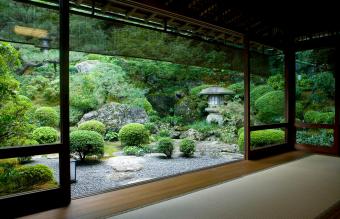
Wabi-sabi is a Japanese aesthetic that celebrates the imperfections and impermanence of life through the arts, nature, and Zen philosophy. The wabi-sabi concept can be used to enhance the natural essence of your feng shui décor and philosophy.
What Is Wabi-Sabi to Buddhism?
The wabi-sabi concept connects with the teachings of Buddhism about the acceptance of the impermanence and imperfection of life. It's through understanding and reconciling these truths that the soul can be set free of the entrapments of the physical world to attain enlightenment.
Appreciation for Beauty
Wabi-sabi is also an appreciation for beauty, especially the beauty found in nature. Wabi-sabi philosophy holds that nothing in life is perfect, and it's the imperfections that result in beauty. The imperfections may be caused by aging, exposure to the elements, or accidental damage. Each blemish is a story that marks the object as authentic and frees it of all expectations of perfection.
Never-Ending Evolution
A third precept of wabi-sabi is that nothing is finished or complete. It is forever evolving and changing. An example might be a tree growing, aging, falling over in the forest, rotting, and petrifying over time. The tree continues to undergo change and becomes more than it was in its original form. The petrified wood has scars, gouges, cracks, and blemishes that when observed and appreciated represent something beautiful and natural.
Modern Wabi-Sabi Concept
From its original meaning of living in nature in solitude with an appreciation for beauty, wabi-sabi evolved into a concept that means something more personal. In modern use, the simplicity of wabi-sabi touches the soul with a feeling of profound personal meaning found in the aesthetics of art and nature.

Simple Beauty
In wabi-sabi, it's the simplicity of beauty that is powerful. Minimalism is often an example of this concept in its barest essence. The form and structure of architecture and how furnishings of your décor fit with it can come together in exquisite beauty.
Imperfection and Feng Shui Principles
In feng shui, the goal is balance of yin and yang energies. Feng shui is based on specific principles and rules. Wabi-sabi isn't about rules or strict guidelines. Wabi-sabi is more fluid and detached. Feng shui will fit any physical location and can be used to conform spaces to its precepts. Wabi-sabi is more elusive and personal. The art of placement isn't expressed in wabi-sabi, since it is more of an acceptance and appreciation of imperfections.
Wabi-Sabi and Feng Shui
Wabi-sabi is not only an appreciation of the natural world, it places value on the forces of nature. This is where the two concepts of wabi-sabi and feng shui dovetail best. The acceptance of nature and its seasons, elements, and natural flow of energy is right in line with feng shui philosophy of placement.
Blending Wabi-Sabi With Feng Shui
Feng shui principles focus on the natural order of life with the goal of achieving balance. Feng shui strives to accommodate the changes that occur in nature with the focus on maintaining balance throughout those changes by adjusting to them. Feng shui recognizes the impermanence of the natural word as well as its imperfections.
Using Wabi-Sabi Concept in a Feng Shui Décor
When applying wabi-sabi to feng shui, you should keep in mind the emotional and spiritual impact décor items and art have on you. When shopping for home or office furnishings, you should apply the wabi-sabi concept. If you don't have an emotional response that leaves you with a sense of appreciation and awareness of self, then don't select it.

Less Is More
The rustic expression found in wabi-sabi can be reflected in a feng shui décor by using simplistic forms, such as a copper object with patina aging. The metal object is a feng shui element that can be used to activate the element in the west, northwest or north sector. Wabi-sabi philosophy is oblivious to this purpose of selecting the object for your décor.
Wabi-Sabi Perception of Beauty
In wabi-sabi, the copper object has aesthetic value in how it personifies life's imperfections with the patina effect. According to the wabi-sabi concept, the patina gives the copper object a profound beauty that can only be created through the aging process. This process transforms the once shiny perfect copper finish into an imperfect appearance that is beautiful.
Wabi-Sabi Celebrates Life's Imperfections
You can use wabi-sabi to gain an appreciation for imperfection as a form of natural beauty. When you apply the concept of wabi-sabi to feng shui, you can honor both ancient art forms to bring greater beauty into your home or office.







